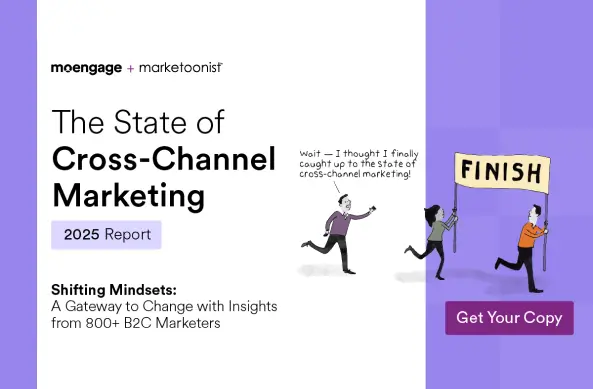7 Factors to Consider While Implementing an Engagement Platform for Retail Brands
This article examines the importance of implementation/onboarding for a brand and explores the steps brands need to take for success implementation.
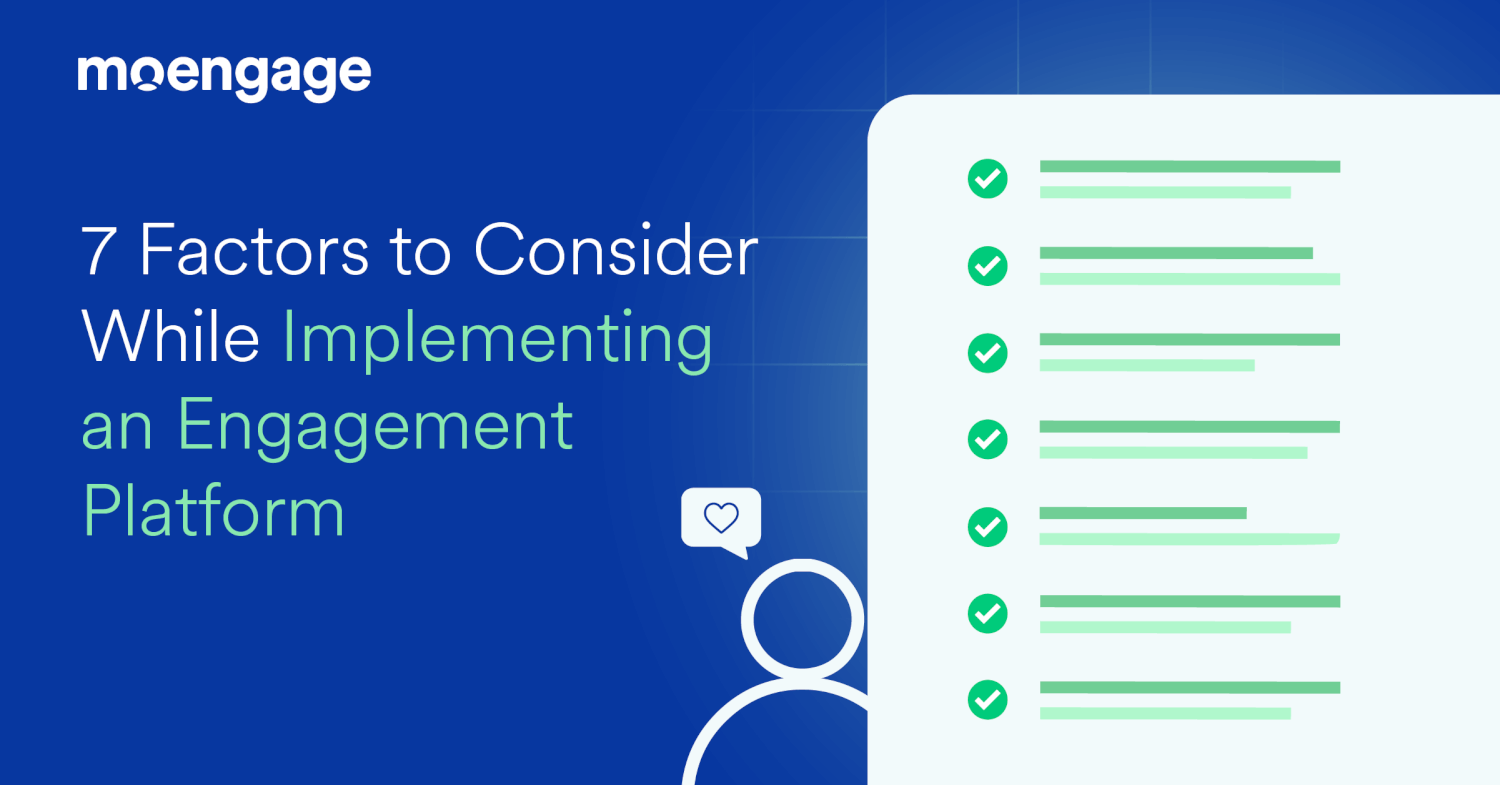
Reading Time: 6 minutes
With the financial year almost over in many regions, the usual routine of looking at the current martech stack, and assessing the gaps will soon commence. This includes (amongst other things) brands revisiting their existing customer engagement platforms or looking to onboard a new one to further enhance their engagement game.
Make your routine analysis much easier and smoother with our recent Buyer’s Guide For Customer Engagement Platforms (Enterprise Edition)
While the decision to upgrade the martech stack with a new customer engagement platform requires utmost research and sincere, internal evaluations, here are a few critical factors to consider:
Questions for the Current Technology Stack
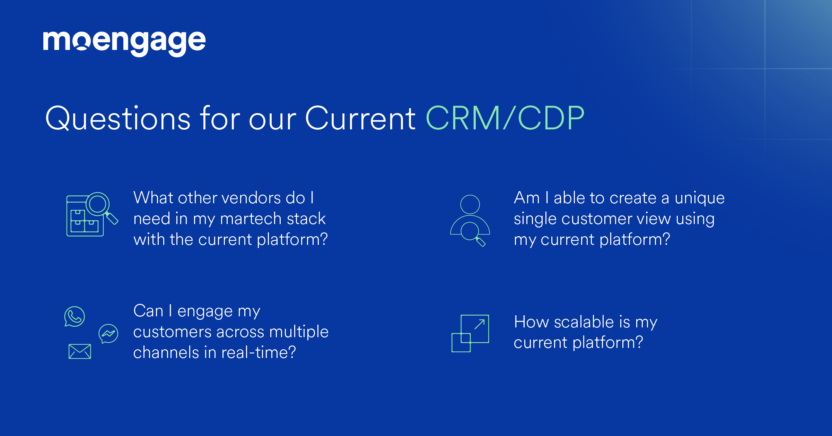
These questions become the starting point in the buying journey of the customer engagement platform. Just like in an F1 track, there are various turns and chicanes that the B2C brand needs to go through before partnering with a customer engagement platform.
One of the critical chicanes is the onboarding and implementation process.
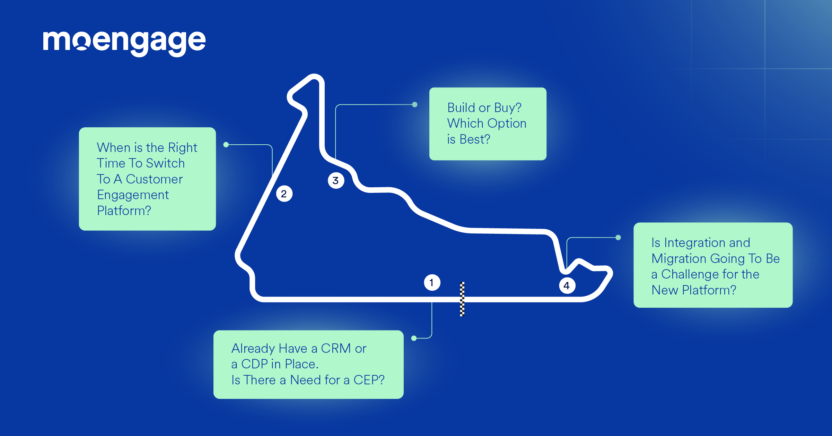
Why Onboarding Process is Important?
Picture this: The engagement platform has been shortlisted, and the paperwork has been completed; however, the implementation takes a long time.
In such a scenario, brands are bound to face temporary setbacks in their engagement strategies:
Financial Losses: The brand may incur direct financial losses associated with the investment made in acquiring the customer engagement software, including licensing fees, implementation costs, and any non-refundable expenses.
Opportunity Cost: The time and resources spent on onboarding a customer engagement platform could have been utilized elsewhere, potentially impacting other business initiatives and growth opportunities.
Productivity Disruptions: Failed implementation can disrupt normal business operations, decreasing productivity as employees may have to revert to previous systems or workflows.
Data Migration Issues: During implementation, issues could result in data inconsistencies or loss. This can significantly impact the accuracy of customer information and marketing efforts, leading to a lack of customer satisfaction.
Therefore, brands need to comprehensively assess the implementation/onboarding process for any customer engagement software as closely as they would look at security, analytics, or segmentation.
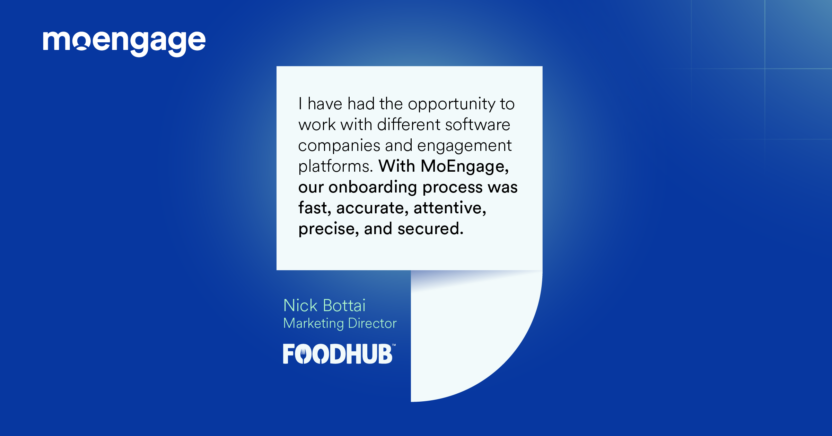
7 Factors That Help in Overcoming the Challenges
The onboarding process of a customer engagement platform into an existing tech stack or business workflow is often complex and requires prior assessment of business requirements. While brands need to understand the abovementioned challenges, here are a few factors to tackle implementation pain points better:
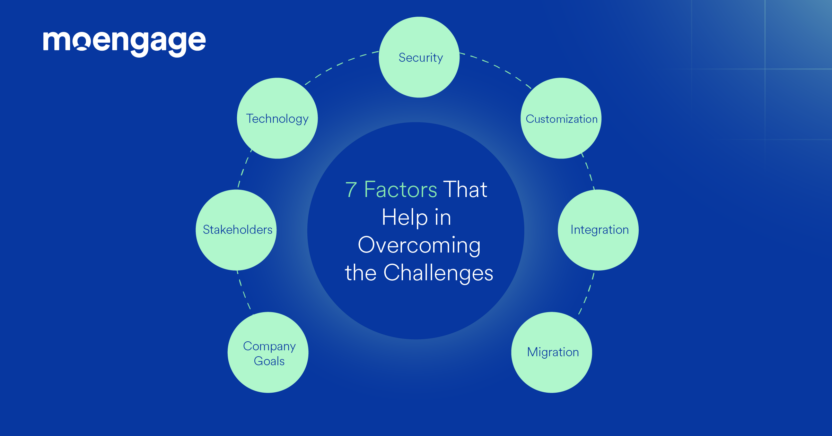
Company Goals: During the buying journey, all relevant decision-makers and influencers must be aligned with the ultimate business goals of the new technology. Be it cost savings, increasing retention, or engaging customers to build a loyal base. To extend this, the brand should also understand the processes that will change.
Stakeholders: Brands must set processes and define critical roles for each individual involved in the implementation. Key stakeholders might include an admin who directs procurement activities internally or an accountant who monitors all the transactional documents.
Defining KPIs: KPIs for successfully implementing engagement platforms can be manifold. From a customer experience standpoint, it can be retention or engagement. At the same time, from a business point of view, a few KPIs to measure can be cost savings or better go-to-market timing. Identifying the specific needs of the most critical KPIs and optimizing those to benefit the brand and the end customer is imperative.
Data Security: Data security is a significant concern. It’s essential to ensure the martech platform with which a brand partner has robust security measures.
Get to know the various compliances that an engagement platform needs to have in our recent Buyer’s Guide For Customer Engagement Platforms (Enterprise Edition)
Integration: Integrating a customer engagement platform with existing on-premises systems can be challenging, mainly if application programming interfaces (APIs) or other integration tools are not readily available. So brands need to know if their customer engagement partner can transfer customers data to any other system like an analytics tool.
Customization: In case of a migration or new onboarding, customization per the brand’s requirements can sometimes be very challenging. There could be scenarios where brands have built various complex flows. So, brands need to understand which customer engagement platforms are best suited for them and how easily they can migrate the already existing complex workflows.
Data Migration: Transferring data from an existing system to a new customer engagement platform can be complex, especially when dealing with large volumes of data or unstructured data. While data security becomes a major hurdle, brands must also evaluate the timelines and the TAT (turnaround time) for all data migration.
MoEngage Tip: It’s also important for brands to check if the data can be shared from their customer engagement platform to any other tool in their martech stack. For instance, using the outbound sync segment of MoEngage, brands can transfer data from MoEngage to any analytics platform.
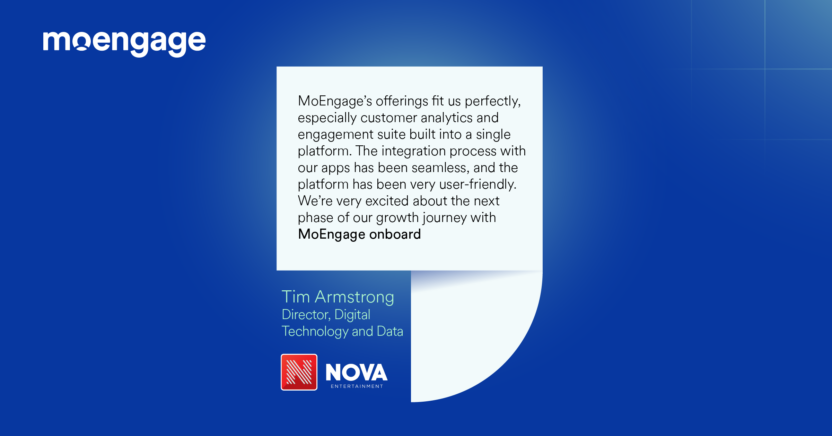
Few Pointers to Note During Implementation
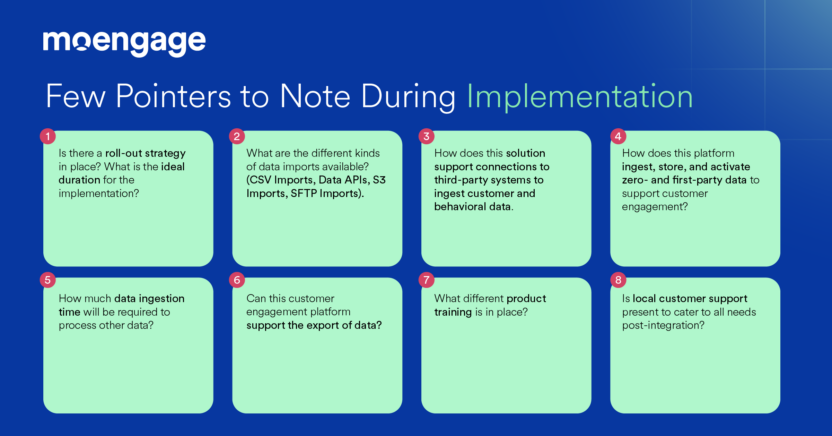
While these above factors will help brands make their buying journey smoother (especially the implementation phase), brands must also examine a few internal factors.
Here are the Few Internal Alignments that Brands Need to Ensure Before Onboarding New tools
Encourage adoption: Teamwork is always essential to build anything good. The same principle applies here as well. A team with sufficient experience and fluency in various technologies surely helps build the right application that caters well to all stakeholders. Team members should also engage in continuous learning to implement the current best industry practices.
Embrace change: Whatever the situation, brands should consider what they want to implement, when they aim to achieve it, and how they can leverage their workforce to increase further adoption. This is where your implementation roadmap and timeline become essential.
Once brands have comprehensively examined all the points, their implementation journey can become much smoother.
Why Brands Love MoEngage’s Onboarding and Support
Using MoEngage, it’s possible to shift the marketing stack in less than seven weeks. As a result, with this swifter implementation, brands have the potential to realize a higher and faster return on investment.
Brands adore MoEngage for its seamless onboarding and support process. Within 24 hours of becoming a MoEngage customer, a dedicated team is assigned, including an implementation manager, project manager, and solutions consultant.
Our phased approach ensures a smooth onboarding journey, starting with a kick-off phase to understand business pain points. The design phase involves detailed conversations with subject matter experts, crafting custom solutions for enterprise and LH customers. Integration follows, utilizing SDKs, APIs, and resources, with thorough testing before the go-live and hyper-care stage. This process takes about 3-4 weeks.
Our team is committed to delivering precision and empathy throughout this comprehensive onboarding journey.
Once completed, the implementation team and the assigned customer success manager of MoEngage work closely to provide any additional client support that may be required during that process. This is completed in week 5 – 7.
Implementation Time to Go Live
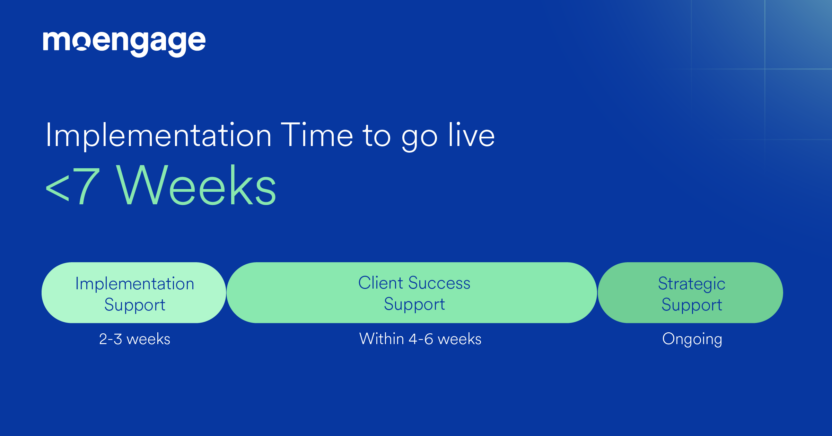
“Embarking on a journey of excellence, successful onboarding becomes the sublime bridge between promise and delivery. In the evolution of MoEngage’s professional services function over the past four years, we’ve transformed from lacking a dedicated onboarding team to mastering the art. Precision, empathy, and time converge as we seamlessly blend technical expertise, project management, and on-site face-time, crafting an extraordinary odyssey for our customers. Our secret? A shared devotion to customer obsession and a resolute customer-first mindset propelling us to redefine excellence in every interaction.” – Niekita Mangla, Global Director, Solutions Consultant for Professional Services.
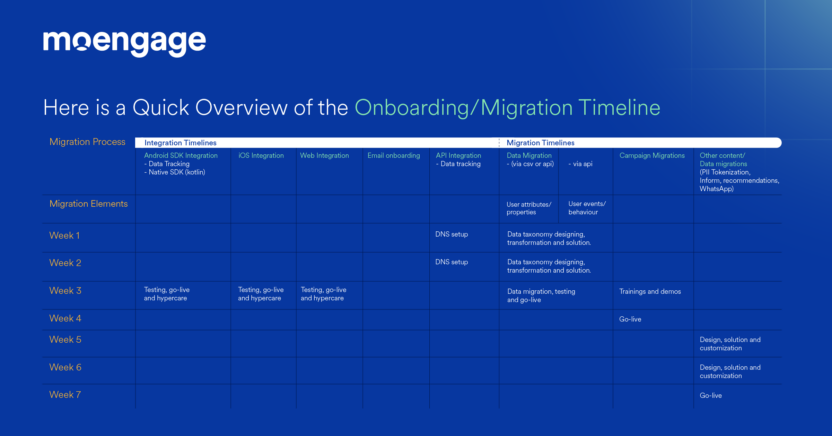
Conclusion
Being vigilant about the implementation (and migration) phase is as important as ensuring scalability (and reliability). As mentioned in the very first sentence of this blog, brands are at risk when the implementation phase isn’t smooth.
Therefore, before deciding on which platform has the greatest symbiotic value, brands should look at different aspects, such as:
- Integration timelines in terms of different channels
- Migration timelines for campaigns and associated data
What Should You Do Next?
- Check out our latest Buyer’s Guide For Customer Engagement Platforms (Enterprise Edition) to get insights on how brands can buy a customer engagement platform.
- Learn how to turn your organization into a customer-centric one in 11 simple steps!
- Still can’t decide between the development of a point solution or an integrated platform? Read our detailed resolution blog!
- Should you build or should you buy an engagement platform? Check out how you can approach and resolve this debate.
- Now that you know the advantages of having an intelligent engagement platform, here are ten questions to help you choose one!

